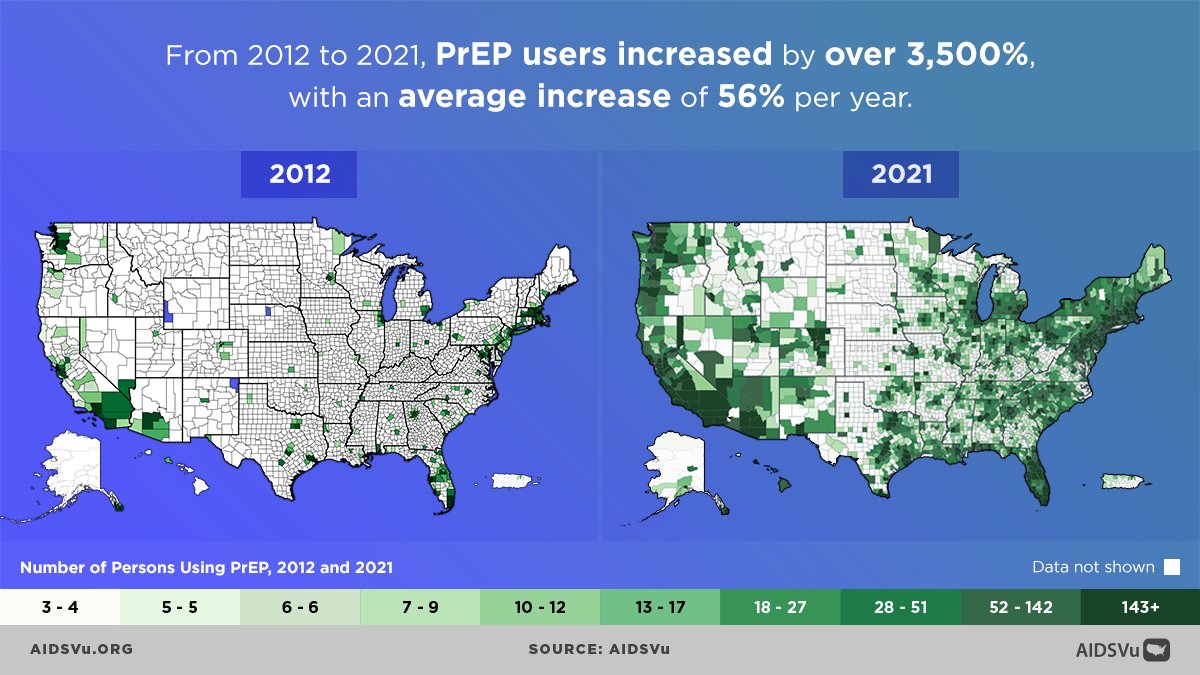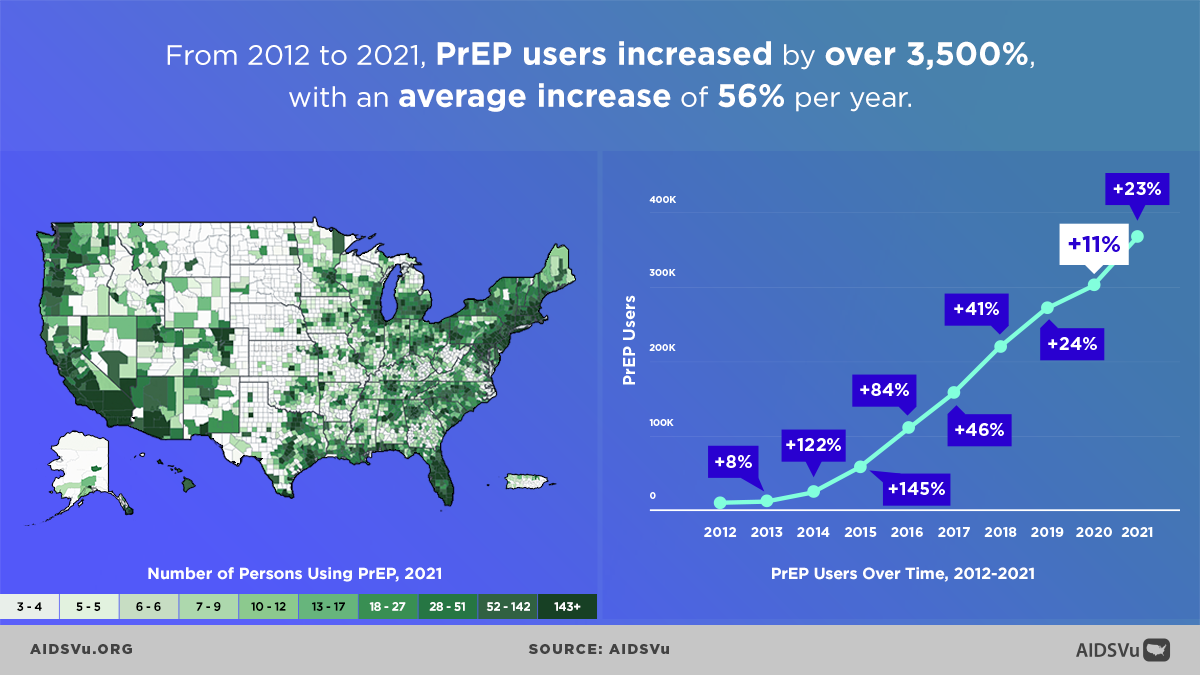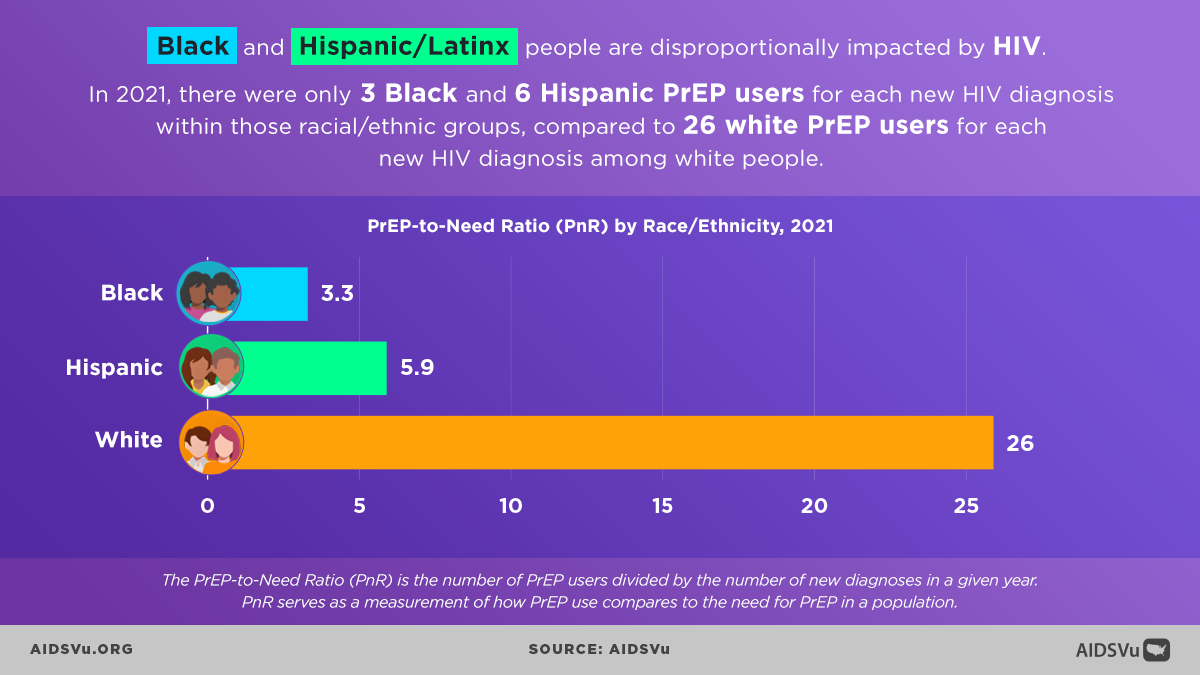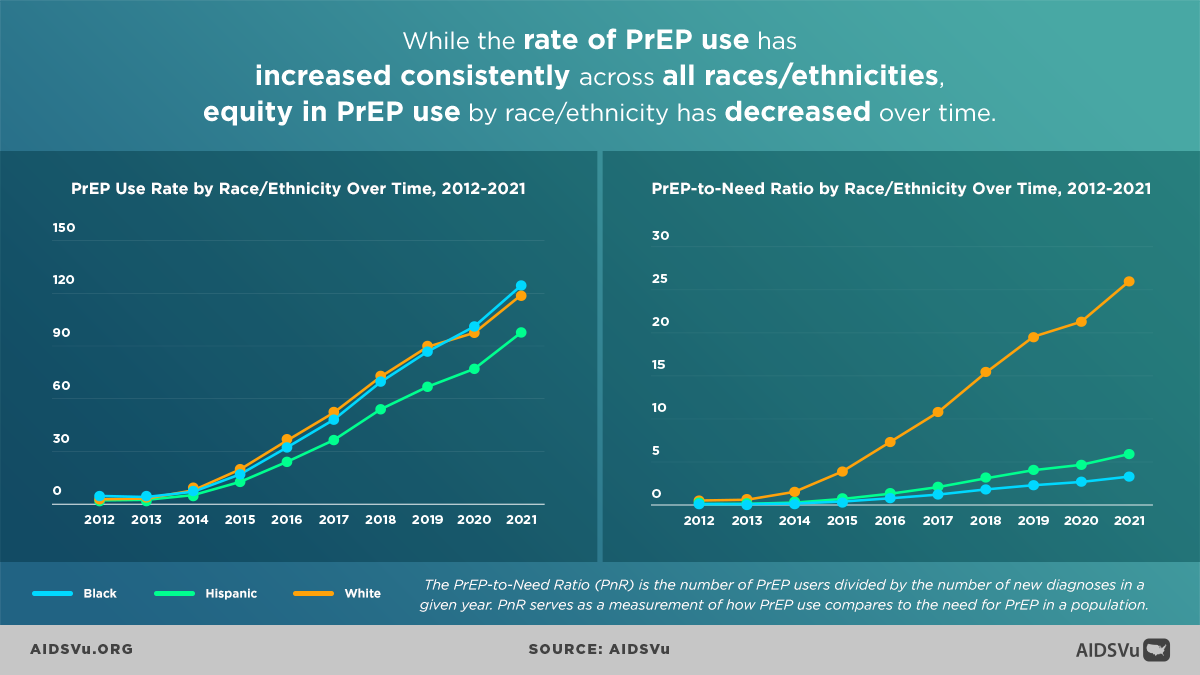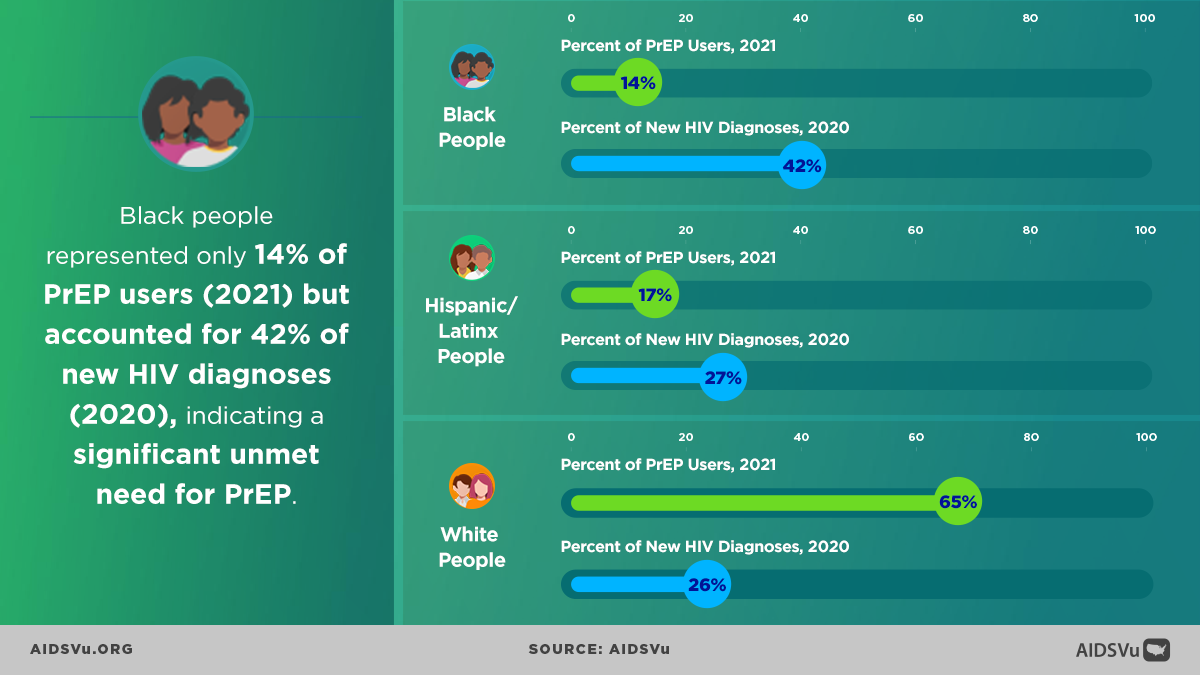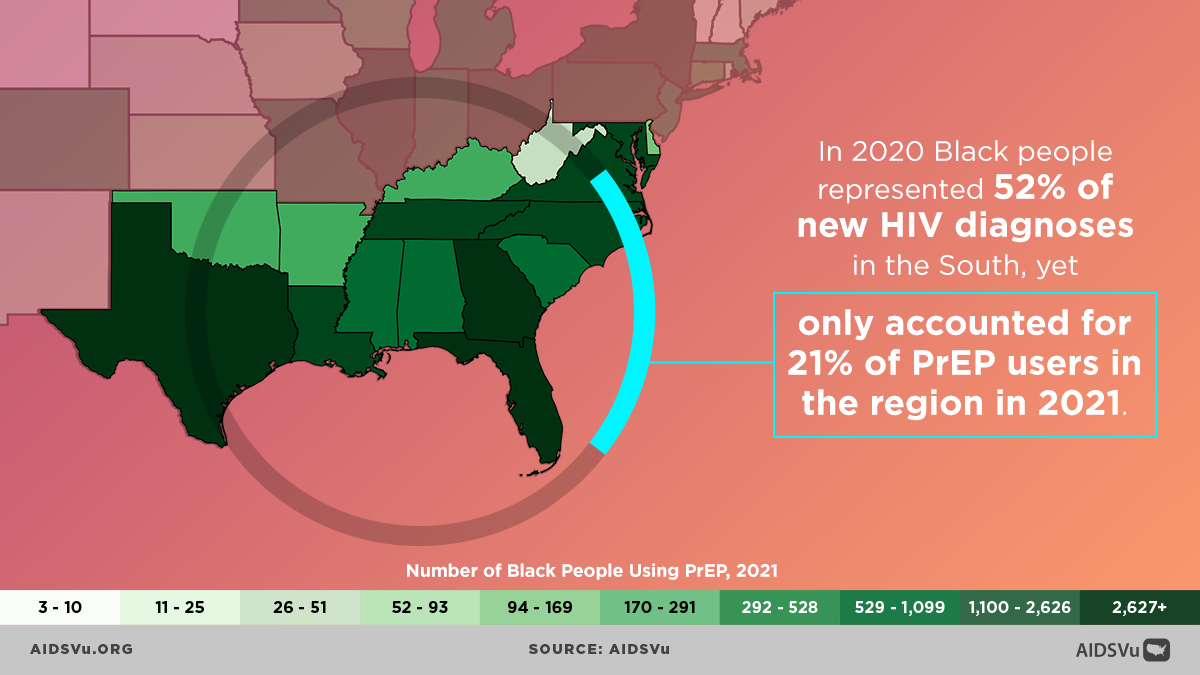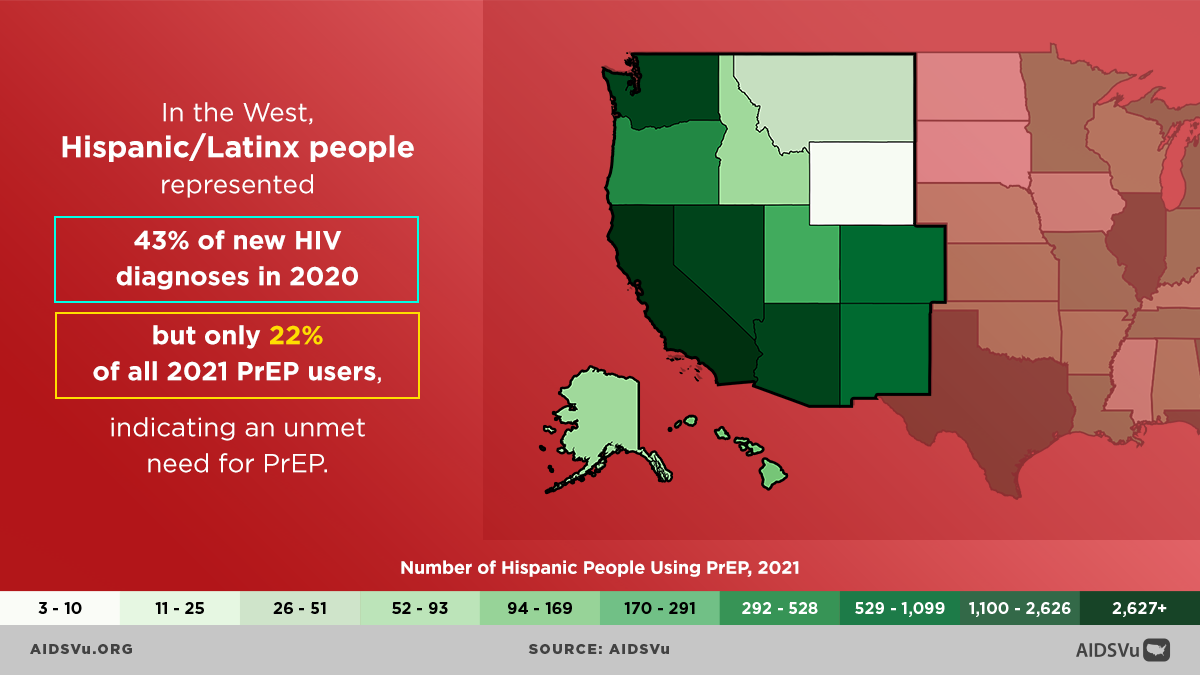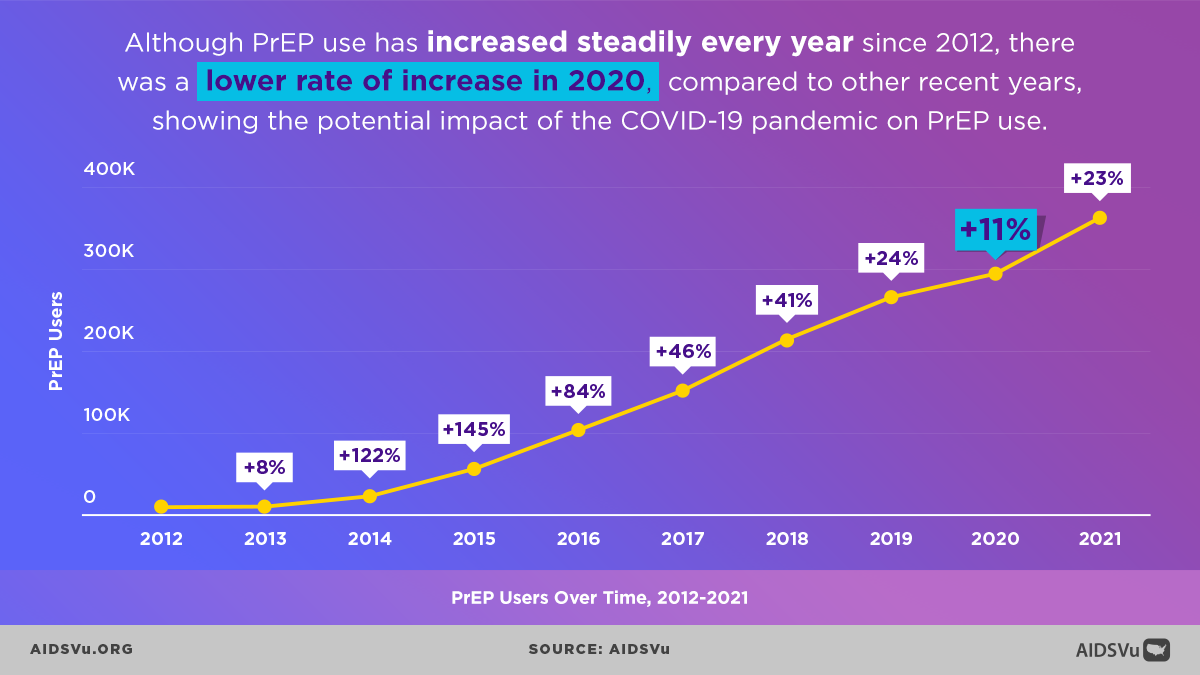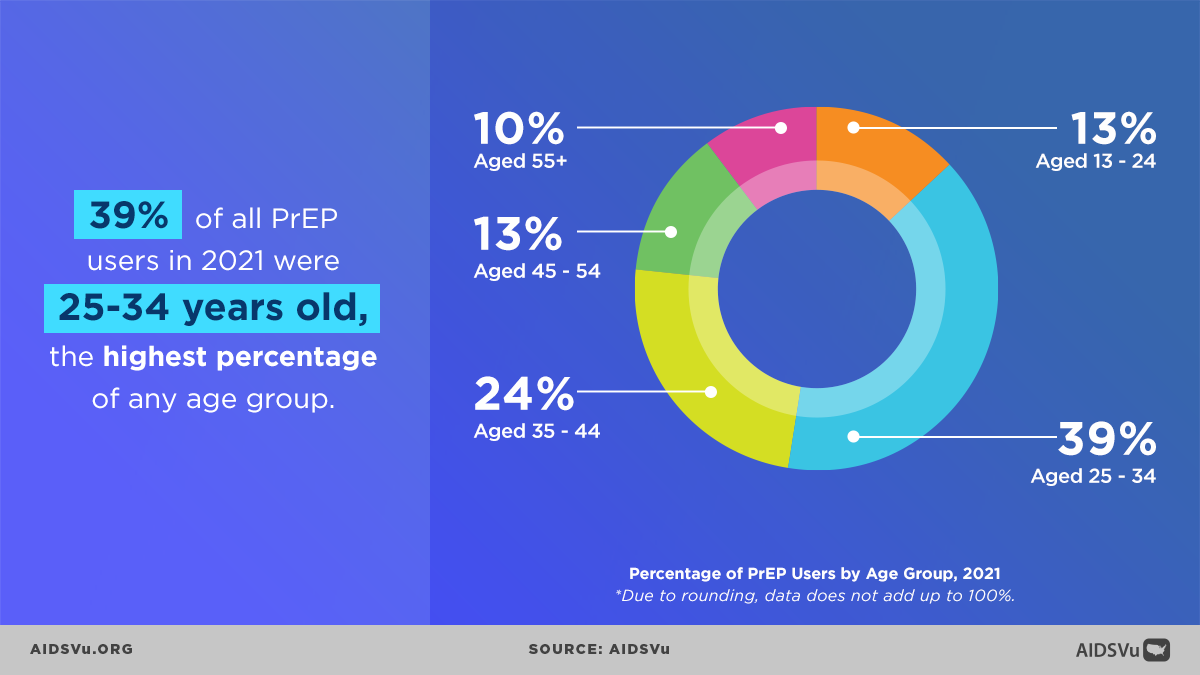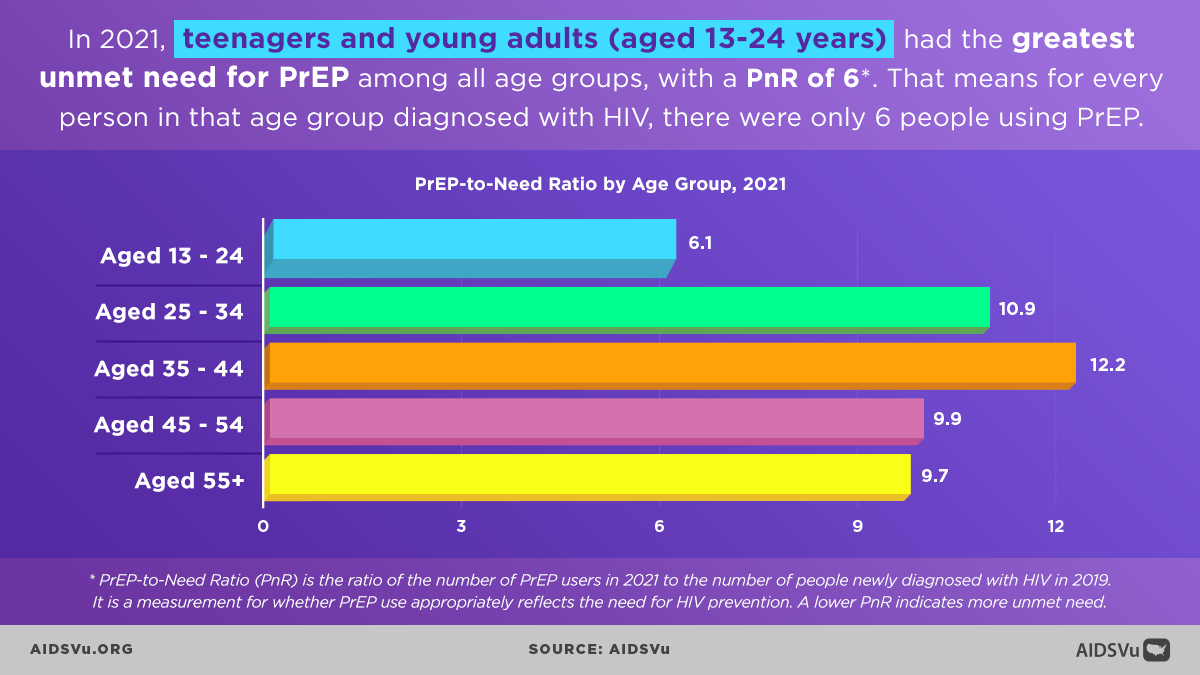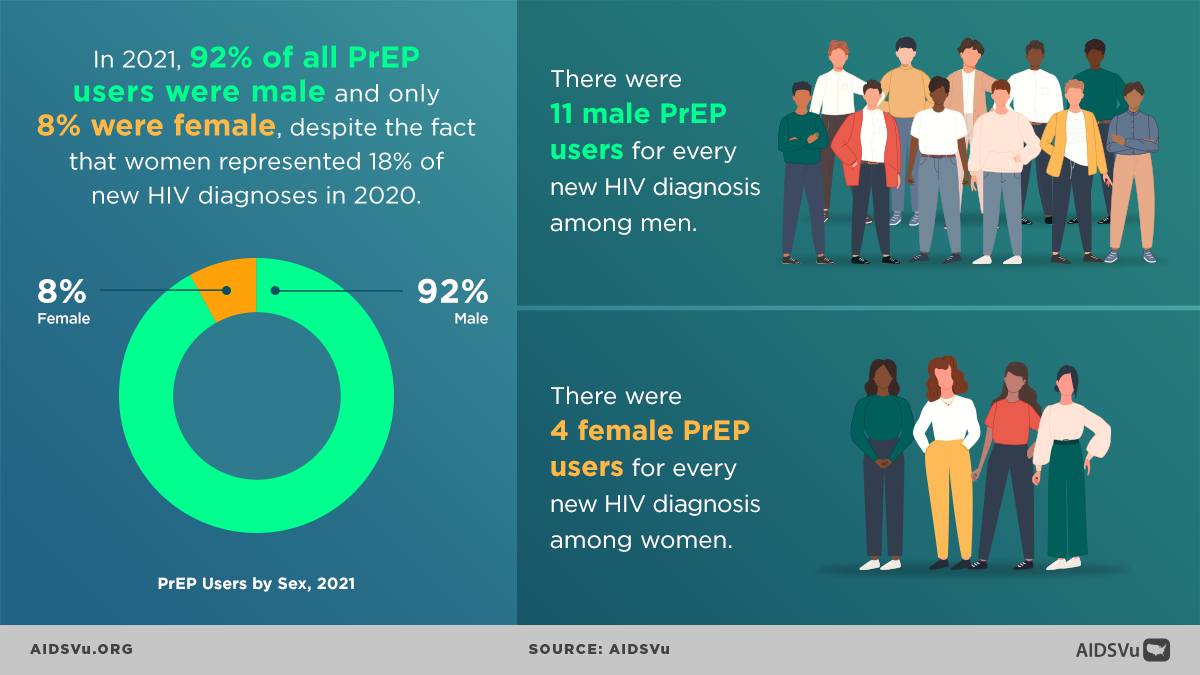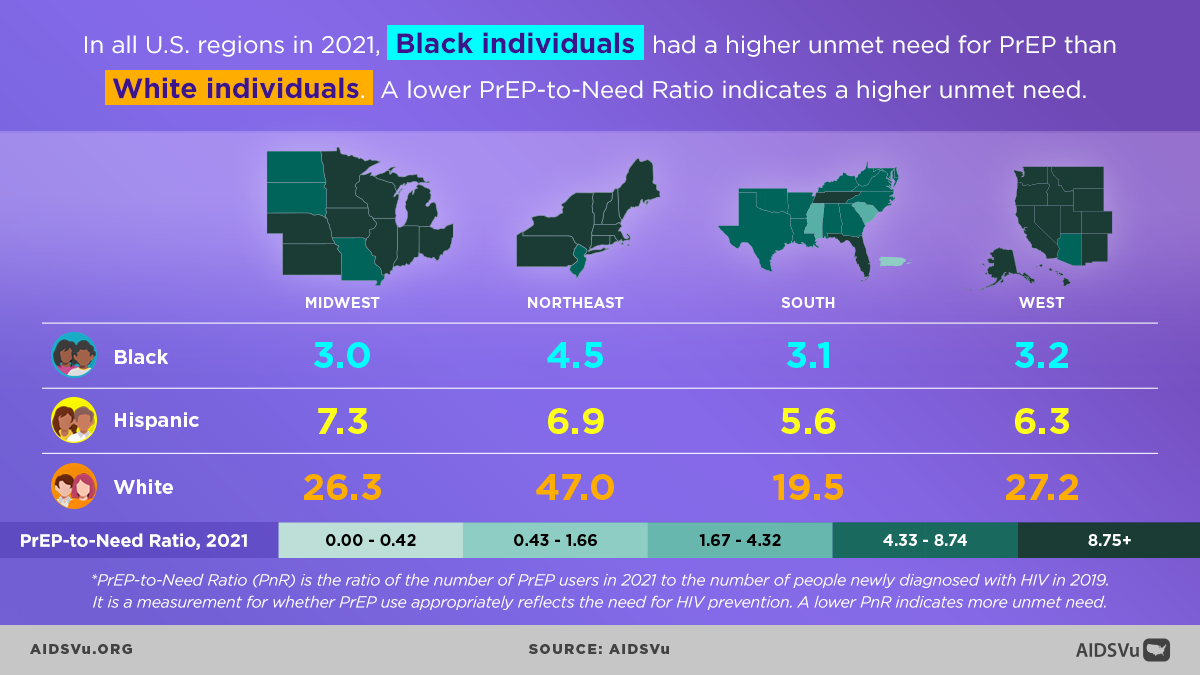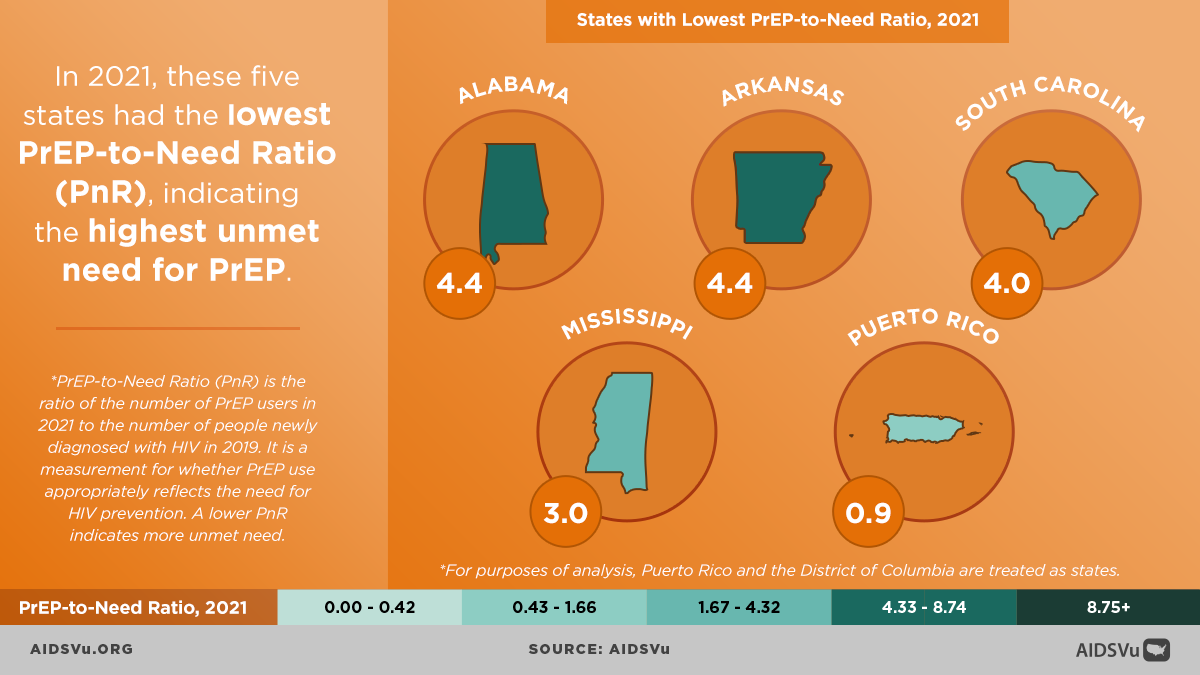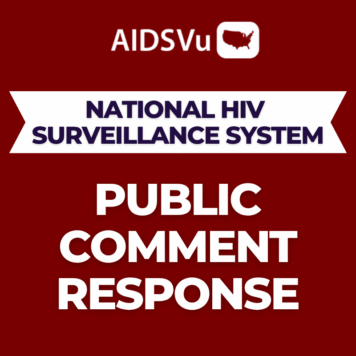ATLANTA – July 29, 2022– Today, AIDSVu released the first-ever publicly available state-level PrEP use data and maps by race/ethnicity from 2012 to 2021, showing that while PrEP use has increased on average 56% each year since its approval in 2012, there are significant inequities in PrEP use among Black and Hispanic people and in the Southern region of the country. In 2021, there were only 3 Black and 6 Hispanic/Latinx PrEP users for each new HIV diagnosis within those racial/ethnic groups, compared to 26 white PrEP users for each new HIV diagnosis among white people. In the South, there were 7 PrEP users for each new HIV diagnosis in the region, compared to 15 PrEP users for each new HIV diagnosis in the Northeast.
These landmark data presented at the 24th International AIDS Conference are now available on AIDSVu, along with the addition of data from 2020 and 2021 to AIDSVu’s existing state- and county-level PrEP use data. Together, these data provide a first look at the potential impact of the COVID-19 pandemic on PrEP use. These data are an important step forward in AIDSVu’s efforts to improve PrEP awareness and uptake, particularly in the communities and areas of the country where it is needed most.
PrEP, or pre-exposure prophylaxis, is medicine that reduces your chances of getting HIV from sex or injection drug use. When taken as prescribed, PrEP is highly effective for preventing HIV. The Centers for Disease Control and Prevention (CDC) has estimated that approximately 1.2 million people could benefit from comprehensive HIV prevention strategies, including PrEP.
“HIV prevention programs should be guided by PrEP use equity – the use of PrEP relative to the impact of the HIV epidemic on that group. Today’s data shows that we have a long way to go,” said Patrick Sullivan, DVM, PhD, Professor of Epidemiology at Emory University’s Rollins School of Public Health and Principal Scientist for AIDSVu. “It is important that data do not live in a vacuum and that the insights we glean from research are translated into policy and action. Visualizing PrEP use data on AIDSVu draws attention to underserved people and geographic regions and helps prevention programs better allocate resources to ensure PrEP reaches the people and communities with the greatest unmet need for PrEP.”
What These Data Tell Us
(PrEP use data is from 2021, and new diagnoses data is from 2020, unless otherwise noted. Due to the COVID-19 pandemic, all data from 2020 should be interpreted with caution)
PrEP Use by Race/Ethnicity
- Black people represented 14% of PrEP users, but 42% of new HIV diagnoses.
- Hispanic/Latinx people represented 17% of PrEP users and 27% of new HIV diagnoses.
- White people represented 65% of PrEP users and 26% of new HIV diagnoses.
- Regionally, Black people made up 52% of new HIV diagnoses in the South, but only 21% of PrEP users in the South; in the Midwest, Black people made up 48% of new HIV diagnoses, but only 12% of PrEP users.
- Of the 7 states with the greatest unmet need for PrEP among Black people, three were in the South (Arkansas, Mississippi, and Alabama) and three were in the Midwest (North Dakota, South Dakota, and Iowa). These states have a PrEP-to-Need Ratio (PNR) of less than 2 (i.e., fewer than 2 PrEP users for every new HIV diagnosis)*.
- In the West, Hispanic/Latinx people represented 43% of new HIV diagnoses but only represented 22% of all PrEP users.
Overall PrEP Use
- The number of PrEP users in the U.S. increased by 23% from 2020 to 2021, continuing a trend of consistent growth in PrEP use since 2012.
- Although PrEP use has increased steadily every year since 2012, there was a much lower rate of increase in 2020 of only 11% from 2019. This lower pace of growth occurred during the COVID-19 pandemic.
- The South accounted for 52% of HIV diagnoses but only accounted for 39% of PrEP users.
- In 2021, states that had expanded their Medicaid programs had rates of PrEP use that were 1.5X higher than states that did not expand Medicaid.
- Among all PrEP users in the U.S., 92% were male and only 8% were female, despite the fact that women comprised 18% of new HIV diagnoses.
- Teenagers and young adults (aged 13-24 years) had the greatest unmet need for PrEP among all age groups, with a PNR of 6*accounting for 20% of new HIV diagnoses but only 13% of PrEP users.
* PrEP-to-Need Ratio (PNR) is the ratio of the number of PrEP users in 2021 to the number of people newly diagnosed with HIV in 2019. It is a measurement for whether PrEP use appropriately reflects the need for HIV prevention. A lower PNR indicates more unmet need.
More PrEP Data & Resources on AIDSVu
Alongside state-level PrEP use data and maps by race/ethnicity, today AIDSVu released additional data and maps on PrEP use at the county- and state-level.
- Single year, county-level PrEP users and rates from 2012-2021, stratified by age and sex
- Single year, county-level PrEP-to-Need Ratio from 2012-2021, stratified by age and sex
- Single year, state-level PrEP users and rates from 2012-2021, stratified by age, sex, and race/ethnicity
- Single year, state-level PrEP-to-Need Ratio from 2012-2021, stratified by age, sex, and race/ethnicity
- Profiles with statistics on PrEP use data at the national, regional, state, and county levels
Additional PrEP resources on AIDSVu include a Deeper Look: PrEP page providing further insights on AIDSVu’s PrEP use and PNR data, downloadable infographics and data sets, and blogs by HIV experts. AIDSVu also features a PrEP Locator, a national directory of public and private practice providers of PrEP across the U.S. AIDSVu users can find local PrEP providers near them with this tool or overlay service locations on top of AIDSVu’s PrEP use maps.
AIDSVu will host a free public webinar on the newly released PrEP use data and findings on August 16, 2022, at 2:00 PM EDT, register here.
About the Data
The release of PrEP use data on AIDSVu was made possible through a data-sharing agreement, in which data were obtained from IQVIA Inc. with the support of Gilead Sciences, Inc., and compiled by researchers at the Rollins School of Public Health at Emory University.
The PrEP use data on AIDSVu represent a reliable and consistent estimate of the number of people who were prescribed TDF/FTC or TAF/FTC for PrEP in a calendar year from 2012 to 2021, excluding prescriptions for TDF/FTC and TAF/FTC that were made for other known indications, such as, post-exposure prophylaxis, chronic hepatitis B management, and treatment for HIV and other opportunistic infections. These individuals are referred to as “PrEP users.” AIDSVu’s PrEP use data are calculated to represent the estimated number of PrEP users in each county and state in the U.S. by year.
The IQVIA database contains anonymized individual-level prescription records collected electronically from U.S. retail pharmacies, traditional pharmacies, specialty mail-order pharmacies, long-term care (LTC) facilities, and “other” pharmacies (e.g., in-hospital pharmacies, HMO pharmacies). The IQVIA database uses national estimates of prescription fills to estimate PrEP prescriptions for the small percentage of U.S. prescriptions that are not tracked directly by IQVIA. The prescriptions database includes age and sex and was linked to a claims database to obtain diagnoses codes. Race/ethnicity was provided through a consumer database of self-reported information. Race/ethnicity data were available for about one in three PrEP users, and data summarized by race/ethnicity on AIDSVu are based on that subset of users.
Race/ethnicity data were available for about one in three PrEP users, and data summarized by race/ethnicity on AIDSVu are based on that subset of users.
AIDSVu continually strives to increase the granularity and usefulness of its publicly available data to inform local public health decision making. Prior to 2020, AIDSVu obtained PrEP use data from Symphony Health and did not have race/ethnicity data. All of AIDSVu’s PrEP data is now obtained from IQVIA. More information on PrEP use data sources, service locator, and more, see our Data Methods and FAQs.
About AIDSVu
AIDSVu.org is presented by Emory University’s Rollins School of Public Health in partnership with Gilead Sciences, Inc. and the Center for AIDS Research at Emory University (CFAR). AIDSVu’s mission is to make data widely available, easily accessible, and locally relevant to inform public health decision-making and action. The platform visualizes data, presents insights, and catalyzes research on the HIV epidemic in the U.S. Each year, AIDSVu strives to increase the granularity of its publicly available data and continues its commitment to provide public health officials, policymakers, healthcare professionals, researchers, and community leaders with a more comprehensive view of the HIV epidemic at the local, state, and national levels.
The statements, findings, conclusions, views, and opinions contained and expressed on the AIDSVu website are based in part on data obtained under license from the following information service(s): LAAD Longitudinal Access and Adjudication Dataset HIV data, January 2012 – December 2021), IQVIA Inc. All Rights Reserved. The statements, findings, conclusions, views, and opinions contained and expressed herein are not necessarily those of IQVIA Inc. or any of its affiliated or subsidiary entities. Any analysis is independently arrived at by Emory University, on the basis of the data and other information.

